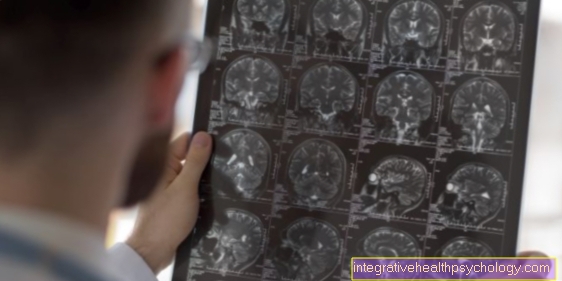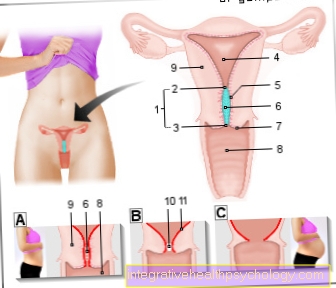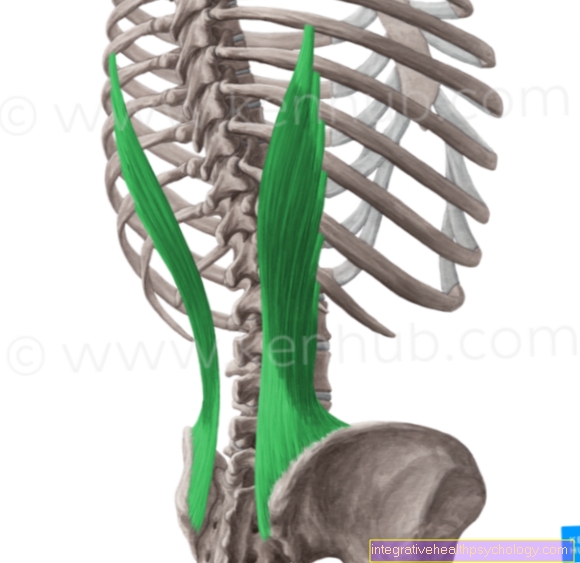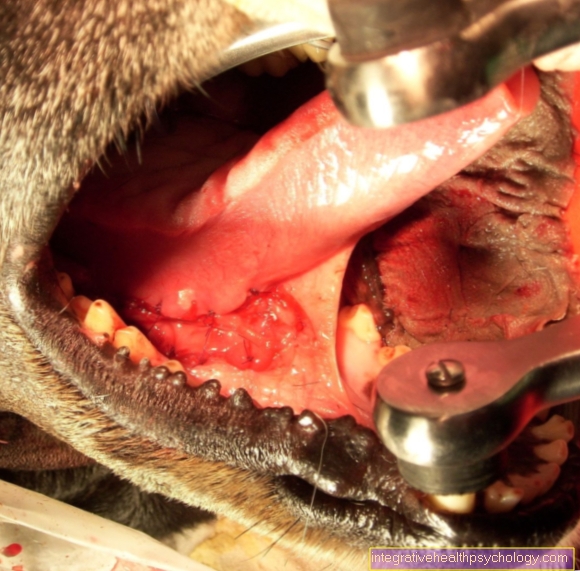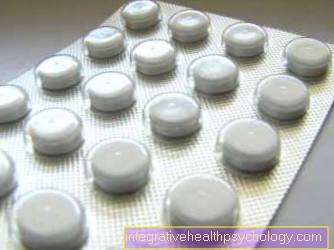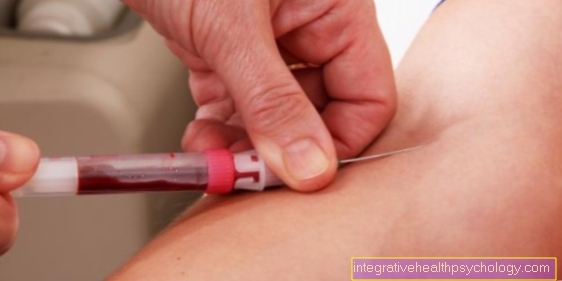Twitching of the thumb
definition
Muscle twitches are sudden contractions of the muscles that are not voluntarily influenced. These can possibly also trigger a movement effect, i.e. a thumb movement. The twitching can vary in strength and basically affect almost all muscle groups in the body, including the thumb, for example.
The eyelids or calves are also often affected. Only slight twitching or trembling movements that can be felt under the skin are called fasciculations. If the twitching repeats itself rhythmically, it can also be called a tremor. The thumb twitching can occur permanently (chronically) or in phases. If the causes are harmless, these symptoms usually disappear after a few days.
You might also be interested in: Twitching of the face
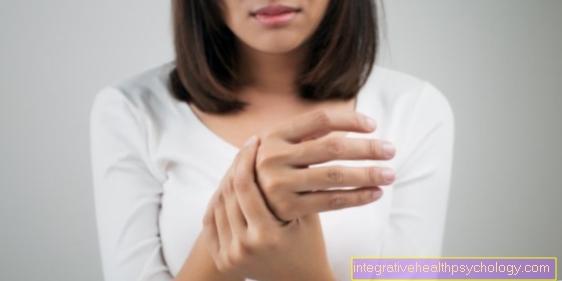
causes
The muscles of the thumb are supplied by various nerves. If these are stimulated or damaged, this can lead to muscle twitching. Most of the time, minor jerks are more of a harmless cause.
One possible cause is malnutrition, for example an undersupply of minerals such as magnesium.
Psychological problems such as fear or stress can also trigger the twitching. Furthermore, the consumption of stimulants such as caffeine can make the twitches easier.
With hypoglycaemia and high fever, a (thumb) twitch can also occur. Physical strain and overload of the thumb can manifest as twitching. Muscle twitching has also been observed as a drug side effect, including with psychotropic drugs, antiarrhythmic drugs, and cancer therapy drugs (cytostatics, immunosuppressants). Other diseases such as thyroid dysfunction can also be the cause.
The twitch of the thumb is rarely caused by diseases of the nervous system. This can be a Parkinson's syndrome, for example, especially if a rhythmic tremor (tremor) occurs. Another cause to be mentioned here is ALS (amyotrophic lateral sclerosis), a progressive disease of the nervous system and, as a result, of the entire musculature. Multiple sclerosis should also be considered.
You might also be interested in: Shaking hands
Concomitant symptoms
The muscle twitching usually takes place without pain, but is occasionally accompanied by painful muscle cramps. This is then known as pain fasciculation syndrome. Sometimes sensory disturbances such as a tingling sensation or a burning sensation also occur.
Muscle twitching may increase with exertion. Another typical spot for muscle twitching is the eyelid, where eyelid twitching often occurs as a physical response to stress. If the underlying disease is systemic, the other symptoms of this disease can of course also occur, for example slow movement in Parkinson's disease.
Twitching of the thumb in Parkinson's disease
Parkinson's disease is a disease of the central nervous system that has not yet been cured. However, the underlying deficiency of the neurotransmitter dopamine can be treated with medication. It usually occurs after the age of 50. Symptoms of dopamine deficiency are slowing down of movement, unsteadiness to walk and stand, muscle stiffness (rigor) and tremors at rest (tremor).
Tremor means that several muscles twitch in motion, with constant tremors. This often occurs on the hand. Usually the symptoms start on one side. The symptoms determine the diagnosis. But you can also test whether the administration of L-Dopa (dopamine) improves the symptoms. This can then also be used as a drug, as can substances that act similarly to dopamine and thus counteract the deficiency.
Read more on the topic: Parkinson's disease
Twitching of the thumb in multiple sclerosis
Multiple sclerosis is a chronic inflammatory disease of the central nervous system in which the covering of nerves in the central nervous system gradually perishes. Since almost any nerve can be affected, the symptoms are varied.
A relapsing course is typical, the first symptoms usually appear between the ages of 15 and 40. Visual disturbances and abnormal sensations of the skin, paralysis and muscle spasms are common. If a certain area of the brain is affected, eye movements (nystagmus), choppy language and intention tremor, i.e. muscle tremors at the beginning of a movement, occur. This can also affect the thumb.
Usually an MRI image of the brain and spinal cord is made to establish the diagnosis. The nerve water (liquor) can also be punctured. The disease is still considered incurable today, but medication can alleviate the symptoms.
You might also be interested in: multiple sclerosis
diagnosis
If the twitching has existed for a long time, occurs very frequently, becomes increasingly stronger or is also painful, you should see a doctor with these symptoms.
Since it is generally a disease of the nerves (if other causes, e.g. have been ruled out by the family doctor), a neurologist is the specialist in charge. The doctor will first want to know exactly what the symptoms are, what the twitching feels like, how often the thumb twitches and whether other symptoms occur. A general survey also includes whether other diseases are known, whether medication has been taken regularly, how the hand is used in everyday life, what is the current situation in life (stress?) And whether the hand may already have been damaged.
A blood test may reveal nutrient deficiencies or other underlying diseases. In order to check the nerve function, examinations such as ENG (electroneurography), EMG (electromyography) or EEG (electroencephalography) can be considered. Further imaging in the form of a CT (computed tomography) or MRI (magnetic resonance imaging) or a sample can be taken from the affected muscle.
Therapy for twitching of the thumb
Treatment for the thumb twitch depends on its cause. Has a certain disease been identified as the cause during the diagnosis, e.g. Parkinson's or another nervous system disease, this is treated and hopefully the symptom of muscle twitching is also alleviated.
If there is an underlying malnutrition, it can be compensated for with appropriate preparations, e.g. Magnesium powder. Medication may also have to be discontinued after consulting a doctor. Relaxation techniques and professional advice help with stress-related twitching.
In general, one should observe when the thumb twitch occurs particularly frequently and avoid corresponding activities if necessary.
Duration of thumb muscle twitches
The duration of the thumb twitches is also variable, due to different causes. If these are caused by an incurable underlying disease, the twitching can be a lifelong companion. If there are more harmless causes such as a deficiency symptom or psychological stress, the twitching will be less or will go away after they have been eliminated.
Often it is enough to observe the twitching first, sometimes this condition stops on its own after days to weeks. If the twitches are very frequent, stressful in everyday life or are still present after weeks or months, you should consult a doctor.
Twitching of the thumb and forefinger
In principle, any muscle can be affected by muscle twitching, so the combination of index finger and thumb at the same time is possible. In addition, the flexor muscles of the thumb (partially) and the index finger are innervated by the same nerve, the median nerve (middle arm nerve).If the twitches are caused by a (local) problem in this nerve, twitches in these two fingers and possibly also in the middle finger are possible.
You might also be interested in: Nerve congestion syndrome
Twitching in the ball of the thumb
The muscles of the ball of the thumb comprise four muscles, which together form the so-called thenar muscles. These muscles are responsible for abduction (splaying), opposition (thumb movement towards the little finger), flexion (flexion) and adduction (approach) of the thumb. Any of these muscles can twitch uncontrollably.
If the abduction or opposition muscle is affected, there may be damage to the median nerve mentioned above. If the adduction muscle twitches, the problem could be with the ulnar nerve. Different parts of the flexion muscle are supplied by one of the two nerves. Diagnostics may show which muscle or nerve is affected.
You might also be interested in: Pain in the heel of the hand - what do I have?

